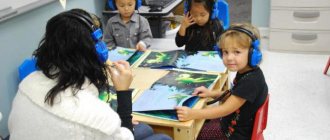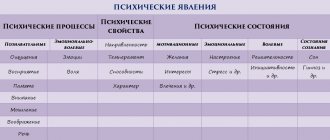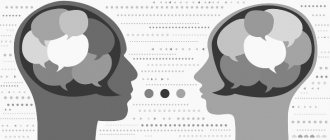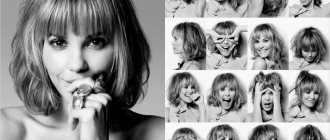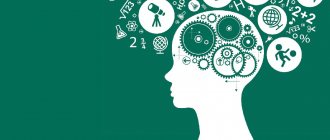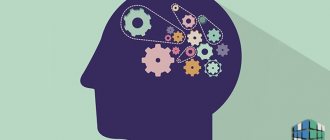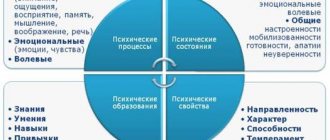Mental processes are one of the most complex, diverse in their manifestations and least studied in the human body. The table presented in this article clearly divides the phenomena occurring in our psyche into three main groups: by properties, states and processes. All this is a reflection of reality, which can be traced in dynamics, that is, each such phenomenon has its beginning, develops and ends with the resulting reaction. Mental processes (the table clearly demonstrates this) interact extremely closely with each other. Mental activity continuously flows from one process to another when a person is awake.
Mental conditions
Processes occurring in the human psyche can be caused by external influences that irritate the nervous system, and can also be born directly in the internal environment of the body, depending on the state in which it is at that moment. The table divides mental processes into three main groups: cognitive, emotional and volitional. Here their components are classified in detail: perception and sensations, memory and representation, imagination and thinking belong to cognitive processes, and active and passive experiences belong to emotional ones. The table reveals volitional mental processes as the ability to make decisions, execution and volitional effort.
Let's take a closer look at the column that represents the state of the human psyche. The table represents motivational, that is, cognitive mental processes most widely, up to the actualization of needs. The reasons are clear: they are the ones who can ensure correct human activity, help form knowledge and regulate behavior. Various cognitive mental processes merge into a single stream of consciousness, a table of which is presented in the article, since a person is a very complex organism, and the mental component is the basis for any life activity. It is she who ensures adequacy in reflecting reality, controlling all types of human activities.
Feel
Sensations are the main source of information about the outside world and about one’s own body; they are one of the main conditions for psychological development. Sensations are channels through which information about environmental phenomena and body conditions reaches the brain. They allow a person to navigate the outside world and his body.
Are you an expert in this subject area? We invite you to become the author of the Directory Working Conditions
All sensations can be divided into three main types:
- Interoceptive is a type of sensation in which signals from the internal environment provide regulation of elementary drives. They provide information about the internal state of the body. These include a feeling of hunger, a feeling of discomfort, a feeling of calm, etc.;
- Proprioceptive - a type of sensation that provides regulation of body movements and provides information about the position of the body in space;
- Extraceptive is a type of sensation that is the basis of a person’s conscious behavior. They are conventionally divided into contact and distance. Contact sensations arise from the direct interaction of a stimulus with the corresponding perceived organ. These include taste and touch. Distant sensations occur when a stimulus and a sensory organ interact at a certain distance. These are sensations such as smell, hearing and vision.
Activity level
The fact that the processes of the human psyche proceed unevenly, with different intensity and speed, is shown by the very first tables on general psychology. Mental processes depend entirely on the state of the individual and external influences on it. What is a mental state? Roughly speaking, this is the relative stability of the level of mental activity, which manifests itself in decreased or increased activity. A person can experience a wide variety of conditions. Anyone can remember that sometimes physical and mental work seemed easy and was productive, and at other times the same actions required a lot of work and still did not achieve the desired effect.
Depending on the state of the individual, the characteristics of mental processes also change; the table clearly shows this. The nature of the processes occurring in the psyche is reflexive; they arise and change depending on physiological factors, the environment, the progress of work, even on verbal influences (from praise and blame, the state of the individual clearly acquires new qualities). The comparison table breaks down the mental cognitive processes of an individual point by point. It contains the most studied factors of such changes. For example, the level of attention can fluctuate from concentration to distraction, characterizing the general mental state, and emotional moods especially clearly change the general background of all characteristics - from sadness or irritability to cheerfulness and enthusiasm. Especially a lot of research concerns the main creative state of the individual - inspiration.
Imagination
Imagination is understood as a cognitive process in which objects and phenomena at a given moment in time are not perceived by the senses, but are formed on the basis of the experience gained. Imagination is closely related to memory and is characteristic only of humans. It can affect body function and movement.
They distinguish involuntary imagination, i.e. the formation of images without any human effort, and voluntary imagination, in which an individual deliberately tries to imagine something specific. Dreams are a special type of imagination. A dream is a conscious process of creating images of what is desired; they show what is important to a person and what he strives for.
Personality traits
Mental properties of a person are stable formations, the highest regulators of activity, which determine the level of the state in the quality and quantity of its components, which is observed in the behavior and activities typical of a particular person. A comparative table of mental cognitive processes connects each gradually formed property of the psyche with the result of practical and reflective activity. The variety of such properties is quite difficult to classify, even in accordance with the basics of all already grouped mental processes.
However, the intellectual, that is, cognitive, volitional and emotional activities of the individual have been studied quite deeply and considered in many complex interactions of their synthesis. Thus, the table shows a variety of mental processes. The properties, functions and role of these components in human life will be considered by us within the framework of this material. Of the cognitive functions, for example, it is worth noting observation and a flexible mind; volitional functions include persistence and determination, and emotional functions include sensitivity and passion. The properties and functions of mental processes differ, but they all play an important role in our daily lives.
Cognitive processes
Visualare a reflection of both achromatic (white, black and intermediate shades of gray) and chromatic (various shades of red, green, blue) colors.
Auditory
are a reflection of sounds of different heights (high - low), strength (loud - quiet) and different qualities (musical sounds, noises).
Olfactory
are a reflection of smells.
Flavoring
are a reflection of certain chemical properties of flavoring substances dissolved in water or saliva.
Tactile
are a reflection of the mechanical properties of objects that are detected when touching them, rubbing them, or hitting them.
Specified
are called exteroceptive and form a single group based on the type of analyzers located on or near the surface of the body.
These sensations are divided into contact
(caused by direct touching the surface of the body - taste, touch) and
distant
(stimuli acting on the senses at some distance - vision, hearing).
Motor
(proprioceptive) reflect the position of the limbs, their movements and the degree of effort applied.
Provisions
(equilibrium), play an important role in the process of perception (for example, stability).
Domestic
(interoceptive), reflect the internal state of the body. These include feelings of hunger, thirst, nausea, etc.
Perceptions are:
- objects and phenomena of the surrounding world;
- person by person;
- time;
- movements;
- space;
- type of activity;
Perceptions of time, motion and space
– these are complex forms of perceptions that have numerous characteristics: long-short-term, large-small, high-low, fast-slow, etc.
Perception of activity
divided by type: artistic, technical, musical, etc.
- externally directed
(perception of objects in the external world).
- internally directed
(perception of one’s own thoughts and feelings).
- erroneous (illusory)
Illusion -
distorted perception of actually existing reality.
Involuntary –
arises without a person’s intention to see or hear anything, without a predetermined goal, without effort of will. It can be caused by the unexpectedness of the stimulus, its strength, mobility, or the contrast between stimuli.
Free –
active, purposeful concentration of consciousness, maintaining the level of which is associated with certain volitional efforts necessary to combat stronger influences. This type of attention is necessary for mastering work skills; performance depends on it.
Post-voluntary –
it comes after the arbitrary one. When the first positive results appear in solving a problem, interest arises, automation of the activity occurs, its implementation no longer requires special volitional efforts and is limited only by fatigue, although the purpose of the work remains the same. This type of attention is of great importance in educational and work activities.
Externally directed (perceptual) –
directed towards surrounding objects and phenomena.
Internal
– on your own thoughts and experiences
.
Natural –
the innate ability of a person to selectively respond to certain external or internal stimuli that carry elements of information novelty.
Socially conditioned –
develops over the course of a subject’s life as a result of training and upbringing. It is associated with a selective conscious response to objects.
Direct
- is not controlled by anything other than the object at which it is directed and which corresponds to the social interests and needs of a person.
Indirect
– regulated using special means, such as gestures and words.
Touch
- aimed at perception.
Intellectual
– aimed at thinking, memory work.
Motor -
aimed at movement.
Genetic (hereditary) –
includes mainly instincts and is almost independent of human living conditions. It is stored in the genotype, transmitted and reproduced by inheritance.
Lifetime
– is a repository of information received from birth to death.
It is divided into: - involuntary -
automatic memorization and reproduction of information that occurs without effort on the part of the person and the mindset to memorize;
—arbitrary
- memorization with a special intention to remember and requiring certain volitional efforts.
Mechanical
– based on repetition of material without understanding it.
Semantic
– involves comprehension of the memorized material, which is based on an understanding of the internal logical connections between its parts.
Short term
– preserves not a complete, but only a generalized image of what is perceived, its most essential elements.
Operational
– designed to store information for a certain, predetermined period, ranging from several seconds to several days.
Long-term
– capable of storing information for a practically unlimited period. This memory receives information that is of strategic importance to a person.
Cognitive
– the process of saving data.
Emotional
– preservation of experiences and feelings in consciousness.
Personal
– ensures the unity of a person’s self-awareness at all stages of his or her life’s journey.
Verbal-logical
– is closely connected with words, thought and logic. A person with such memory can quickly and accurately remember the meaning of events, the text being read, and the logic of reasoning.
Visual
– associated with the preservation and reproduction of visual images.
Auditory
– memorization and accurate reproduction of various sounds (musical, speech).
Motor
– represents the memorization and preservation, and, if necessary, reproduction with sufficient accuracy of a variety of complex movements.
Tactile, olfactory, gustatory -
play a smaller role in human life, which mainly comes down to ensuring the safety and self-preservation of the body.
Theoretical –
knowledge of laws, rules, development of concepts and hypotheses.
Practical
– preparation for the transformation of reality.
Analytical
– is temporary, structural, conscious in nature.
Realistic –
directed to the outside world and governed by the laws of logic.
Autistic
– associated with the realization of human desires.
Productive –
recreating thinking on the basis of novelty in mental activity, and
reproductive
– reproducing thinking in a given image and likeness.
Involuntary - involves the transformation of dream images, and voluntary -
purposeful solution of mental problems.
Oral –
communication using linguistic means perceived by ear.
Monologue –
extended speech of a person addressed to other people.
Dialogical –
is an alternating exchange of remarks or detailed debates between two or more people.
Internal –
silent hidden speech about oneself and for oneself, arising in the process of thinking.
Written
- unlike monologue, it is constructed using written signs
.
Passive intentional –
images and fantasies, deliberately evoked, but not associated with the will.
Passive unintentional
– occurs when the activity of consciousness weakens, with its disorders, in a half-asleep state, in a dream.
Active Recreation -
is based on the creation of images that correspond to the description.
Active creative –
independent creation of new images that are realized in original and valuable products of activity.
Synthesis
The properties of the human psyche do not exist separately; they act in synthesis, forming complex structural complexes. There is a classification of manifestations of the unconscious according to mental processes. A table of such states is presented below.
This includes the following processes that synthesize with each other:
- Life position: needs, interests, beliefs, ideals, personality activity and selectivity.
- Temperament is the natural properties of a person: balance, mobility, tone, other behavioral characteristics, everything that characterizes the dynamics of behavior.
- Abilities: a whole system of intellectual, volitional, emotional properties of a person that can determine creative possibilities.
- Character is a system of behavior and relationships.
Interconnected neuropsychic acts in their stable and purposeful totality have a certain scheme for transforming activity to obtain a certain result. These are the mental processes characteristic of each individual, which are of primary value for study. For example, memory as a mental process requires memorizing information; this is its need - conscious and unconscious. Here, the input to the process will be precisely this requirement as a property, and the output or final result will be the information remaining in memory.
Psychic phenomena
The most common mental processes were listed above, but let's look at these lists in more detail. They vary greatly among different authors. Common and noted by all are attention, emotions, memory, feelings, sensations, will, thinking, perception, speech. In the category of mental phenomena, they are accessible to any direct and unqualified observation.
Most often, what is interesting is not even the observed process itself, but its deviations from the norm, that is, its characteristics. Here, the usual table of features of mental processes usually helps students understand the classification. Children of all categories are studied especially carefully, but even their cognitive processes can be quite easily distinguished from emotional or volitional processes.
Back Next
Sensation is the first stage of cognitive activity. Sensation provides information about only one property (quality) of an object or phenomenon when it directly affects the sense organs (analyzers). For example, sensation can provide information about the properties of objects and phenomena around us, such as hot or cold, heavy or light, bright or dark, loud or quiet, etc.
Feelings can be roughly divided into:
- exteroceptive (signals from the outside world; according to analyzers: visual, auditory, tactile, olfactory, taste sensations)
- proprioceptive (signals about the position of the body in space)
- interoceptive (signals from internal organs)
Properties of sensations (the information they provide):
- modality (quality; basic information displayed by a given sensation; for example, taste sensations provide information about some chemical characteristics of an object: sweet or sour, bitter or salty; temperature sensitivity - about temperature, etc.)
- intensity (depends on the strength of the current stimulus and the functional state of the receptor, which determines the degree of readiness of the receptor to perform its functions; for example, with a runny nose, the intensity of perceived odors can be distorted due to difficulties in the functioning of the receptors)
- duration
- spatial localization
Synesthesia (“shared feeling”) is a feature of sensory cognition when, along with a modality of sensation specific to a particular stimulus, sensations of other modalities arise. The most famous example: color hearing, i.e. the ability to perceive certain colors along with sounds. The phenomenon of synesthesia itself is not a pathology; it is believed that it is important for the development of finely differentiated processes of perception, especially in musicians, artists, tasters, etc.
Perception is a mental process that allows you to obtain information about phenomena and objects as a whole, in the totality of their properties , and to form their holistic image. Perception ends with recognition.
Perception is not just the sum of sensations, but rather the process and result of their processing. It involves the systematization and interpretation of information coming from the senses (including based on past experiences stored in memory - see presentation).
Perception is a complex process in which many areas of human mental activity are involved: attention
(necessary for separating an object from the background),
memory
(recognition is based on information stored in memory),
thinking
(for example, identifying and comparing the most important features),
motor sphere
(for example, “palpating” eye movements when examining objects, etc.),
emotions
(as will be seen below, a significant part of the symptoms of impaired sensory cognition are associated with certain emotional states) and even
personality traits
[thus, in some areas of psychology theories have been developed about the connection between cognition and temperamental characteristics, cognitive “styles” of personality, etc. .d.].
The ability to perceive is not innate; the processes of perception go through successive stages of development in a child in the first years of his life. He gradually learns to examine and distinguish objects around him, listen to sounds, remember images and their designations, etc. At the same time, “learning” in complex aspects of perception can occur not only in children, but also in adults throughout life (for example, the formation of differentiated perception of shades of taste in wines, the sound of heart sounds during auscultation, etc.). As we will see later, just as gradual as the formation of perception processes can be their disintegration due to pathology of the corresponding centers of the cortex (see agnosia).
Perception can be distinguished:
- objects and phenomena (subject perception)
- space
- movement
- time
Representation is the process of reproducing in memory or imagination visual images of objects or phenomena that do not currently affect the senses (i.e., these images are based on preserved past sensations and perceptions).
A representation is called both the process itself and the result of this process, i.e. represented image.
Each of us can imagine in our “mind’s eye” an image of almost any object or phenomenon that we have often encountered before, or experience at least a one-time, but quite vivid and memorable meeting. For example, we can imagine the image of the president of our country, a car of our favorite brand, an airplane, imagine the sound of the voice of a famous actor, etc. In other cases, having set an appropriate goal, we can imagine some unrealistic image (for example, a person with 100 arms) , i.e. something we have never seen in life, but we will combine this image from what we have previously encountered in life.
In fact, the ability to imagine such images is expressed differently in different people, some do it better (usually artists, designers), some do it worse.
The images presented are usually unstable, i.e. when our focus shifts to something else, they quickly fall apart. These images are projected into a certain subjective space that is not connected with the real space surrounding a person at the current moment (i.e. we can imagine something very large, for example an airplane, the size of the room in which we are located does not matter at all , because the represented images are in no way connected with this real space).
Images of ideas can arise voluntarily (in accordance with our volitional effort) or involuntarily (for example, looking at a lemon, we often involuntarily imagine its sour taste). Dreams can also be classified as involuntary ideas.
Since ideas arise in the absence of objects acting on the senses, they are less vivid, less detailed, and more fragmented than the usual perception of real objects. At the same time, representations are more schematized and generalized than perception, since they reflect the most characteristic features characteristic of a whole class of similar objects. The degree of generalization in representations may vary. The so-called single ideas (for example, the image of one’s mother) are individual and specific, although they also contain a certain degree of generalization, since they are summarized images of many perceptions of a specific object. General ideas are more abstract and combine previously perceived images of many similar objects (for example, the image of a mother as a whole as a generalized image of a woman raising her children).
Representation is a transitional step from perception to abstract logical thinking (i.e. to abstract concepts). Unlike concepts, representations do not yet contain the identification of internal, natural connections and relationships hidden from direct perception.
One can imagine the following conventional sequence of stages of information processing, moving from the process of sensation to thinking:
- sensation (for example, the weight of a fellow passenger stepping on your foot in the subway)
- perception (for example, a fellow passenger with whom you are traveling on the subway, who just stepped on your foot and whom you are now considering)
- representation (for example, the image of that fellow traveler on the subway who stepped on your foot yesterday)
- concept (for example, about the characteristics of fellow travelers who usually step on their feet painfully in the subway)
Neurobiology of the processes of sensation, perception, representation
Primary, subcortical processing of information coming from all senses (with the exception of smell) occurs in the thalamus (visual thalamus). Further processing occurs in the cortical centers of analyzers - primary (projection, assessing individual parameters of objects), secondary (carrying out a more complex, comprehensive analysis of perceived information) and tertiary (associative, combining information from different analyzers). Moreover, processing of incoming information can be carried out at different “levels” and in different “directions”.
For example, for visual perception: from the primary visual centers located in the occipital lobes of the cerebral cortex, information goes in two directions for further processing: dorsal (towards the back of the parietal lobe of the cortex) and ventral (towards the lower part of the temporal lobe of the cortex).
The dorsal flow of information (the “where?” channel) is necessary for assessing space, localizing an object in it, and assessing its movement; this information determines the eye movements necessary for the holistic perception of the object.
The ventral flow of information (the “what?” channel) is associated with object recognition and subject perception. Moreover, as information “moves” from the primary visual cortex (occipital) along the ventral stream (towards the pole of the temporal zone), an increasingly differentiated perception of objects occurs. Images of representations are “stored” in the temporal cortex , and recognition occurs on their basis. The localization of this “storage” is semantically organized (by semantic categories, i.e. objects belonging to the same category are stored nearby).
These neurophysiological features of perception make it possible to understand various types of pathology of perception, for example, various types of agnosia or hallucinations.
Back Next
To see comments you must register
Personality Features
People are endowed with completely different capabilities: one is absent-minded, and the other is attentive, this one perfectly remembers faces, and the other only remembers melodies. In addition, behavior is characterized by any mental phenomenon and the degree of balance: some will be delighted by the surprise, some will be surprised, and some will be left indifferent. People treat each other differently: some love those around them, while others find humanity disgusting. There are people who are persistent, even stubborn in achieving their goals, and also those who do not care about anything - they always remain apathetic and lethargic.
Attitude to science
Russian psychology divides all mental phenomena into three types: properties, states and processes. The differences between them are not so great and are temporary. The processes usually take place quickly, but the properties are more stable and long-lasting. Modern psychologists believe that through the interconnectedness of mental processes, the psyche itself is formed, which can be divided into components only very conditionally, since there is no theoretical justification for this study. Nevertheless, not only major phenomena of the work of the psyche have been quite widely identified and studied, but also basic mental processes, for which there is far from a single comparative table.
But since psychology has become a science, scientists are developing methods for its knowledge, where the main postulate is an integrative approach to the human psyche, and all classifications in the tables are of propaedeutic and pedagogical value. Similar processes occur in society. Just as in the psyche of an individual, they are extremely interconnected in society: children study, parents raise them, work, athletes train, alcoholics drink, the police catch criminals, and so on. No matter how parallel these processes may seem, sooner or later they all intersect with each other in some way.
Will and emotions
Throughout his life, a person reproduces his existing skills, knowledge, and abilities, trying to connect various forms of behavior with his existing emotional state. In this way, the actualization of connections between various mental processes is built, their transition from latent to active form is carried out. Among emotional states, the most striking is affect. This is a stormy, rapidly flowing emotion of enormous power, which looks like an explosion, therefore it is uncontrollable by consciousness and is often pathological.
But the process that concentrates consciousness on a real or ideal object is attention. But it is not emotional. A special ability regulates and self-determines its own activity. This is will. All mental processes can be subordinated to it. Its main properties and functions are the precise choice of goals and motives, the regulation of impulses for certain actions, even if there is a lack of motivation, the organization of those mental processes that can fit into the system of adequately performed activities, the mobilization of mental and physical capabilities if it is necessary to overcome obstacles on the way towards the set goal.
Cognition and Intelligence
The tools for adequately reflecting and projecting the world surrounding a person are representation and imagination. They are closely connected with nonspecific brain structures at the cortical level and make it possible to build the dynamic characteristics of maturing mental processes. These are speed and quantitative indicators of certain actions and their implementation. The state in which the individual’s psyche is located can be different, hence the high variability of performance results.
Speech is in the closest connection with thinking, approximately as closely as sensations and perceptions - one follows from the other. These cognitive processes of the psyche are characteristic of any activity, since it is they who ensure its effectiveness. With the help of basic cognitive processes, a person can set necessary goals in advance, make plans, fill upcoming activities with content, predict results and manipulate them as work progresses. The table presented in the article demonstrates mental cognitive processes and their characteristics as intellectual.
Structure and functions
Cognitive processes in psychology are considered the “youngest”. Even the centers of these processes are located in the neocortex - the youngest part of the cerebral cortex, with the exception of the centers of attention and memory.
However, these processes are at the same time extremely important for humans, since they perform a number of necessary functions:
- Reception of new information and its differentiation, for which there are different channels of information (visual, auditory, olfactory, etc.).
- Processing primary information and creating holistic subjective images.
- Data storage.
- Establishing connections between different types of sensory information, concepts, images, as well as connections between new information and existing information.
- Creation of concepts and signs, establishment of patterns between phenomena and processes of the surrounding world; signs are also used for communication, which is the basis of speech.
- Creating a strategy of behavior and its motives.
- Formation of goals and long-term objectives of activity.
- The ability to foresee the results of actions and plan one’s behavior.
A person's level of intelligence is determined by how effectively his cognitive processes perform their functions. Understanding the world around us, of course, does not happen spontaneously and chaotically.
It has a certain structure and consists of several stages
:
- First, the brain receives new information and processes the received data.
- Then he uses methods of analysis, synthesis, comparison and generalization.
- The information received is remembered and saved.
- From the information received, new information is created - in the form of images and concepts.
- Finally, at the highest level of cognition, complex operations with data, including those of a predictive nature, are carried out.
conclusions
The psychological process is most simply explained by a person's ability to remember, think and anticipate. Most often this concept is associated with the acquisition of knowledge. Cognitive mental processes are always creative and active in nature, not so much reflecting the world around us as transforming it. There are two ways of cognition - specific and non-specific. The first uses sensory and rational processes - these are sensations, perception and thinking, in the latter there is a concept, judgment and inference.
Universal, or nonspecific, mental processes are memory, will, imagination, attention. They operate in an end-to-end manner, providing connections throughout the entire cognitive process, and it is on them that all behavioral processes that are in synthesis depend. This supports the cognitive activity and practical objective activity of the individual, who receives not only individuality, but also originality and uniqueness.
Material on psychology - table “Cognitive processes”
Abstract thinking– thinking using concepts that accompany symbolization.
Logical thinking
- a type of thought process in which logical structures and ready-made concepts are used.
Accordingly, abstract logical thinking
is a special type of thought process that involves the use of symbolic concepts and logical constructs.
Divergent thinking
- a special type of thinking that assumes that there can be many equally correct and equal answers to the same question.
Convergent thinking
- a type of thinking that assumes that there is only one correct solution to a problem.
Visual - actionable thinking
- a special type of thought process, the essence of which lies in practical transformative activity carried out with real objects.
Visual – imaginative thinking
- a special type of thought process, the essence of which lies in practical transformative activity carried out with images.
Creative thinking
is thinking that uses images. (figurative logic plays a leading role)
Practical thinking
- a type of thought process that is aimed at transforming the surrounding reality based on setting goals, developing plans, as well as perceiving and manipulating real objects.
Theoretical thinking
– one of the types of thinking that is aimed at discovering laws and properties of objects.
Creative thinking
- one of the types of thinking, characterized by the creation of a subjectively new product and new formations in the course of the cognitive activity of its creation.
Critical thinking
– represents a test of the proposed solutions in order to determine the scope of their possible application.
Prelogical thinking
- a concept introduced by L. Lévy-Bruhl to designate the early stage of the development of thinking, when the formation of its basic logical laws has not yet been completed - the existence of cause-and-effect relationships is already realized, but their essence appears in a mystified form.
Verbal - logical thinking
– one of the types of thinking using concepts and logical constructions.
Spatial thinking
is a set of mental sequential operational spatial transformations and simultaneous figurative vision of an object in all the diversity and variability of its properties, constant recoding of these different mental plans.
Intuitive Thinking
- one of the types of thinking. Characteristic features: rapid progression, lack of clearly defined stages, little awareness.
Realistic and autistic thinking.
The latter is associated with withdrawal from reality into internal experiences.
